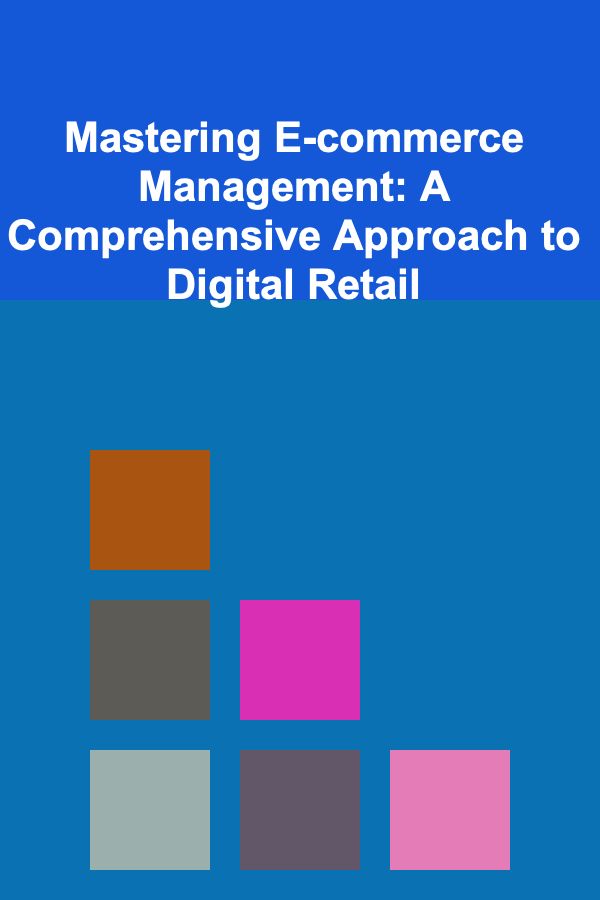
Mastering E-commerce Management: A Comprehensive Approach to Digital Retail
ebook include PDF & Audio bundle (Micro Guide)
$12.99$5.99
Limited Time Offer! Order within the next:

The e-commerce landscape has evolved dramatically over the past few years, and with rapid advancements in technology and consumer behavior, the path to success in digital retail has become more complex. For businesses to thrive in this highly competitive and constantly changing environment, mastering e-commerce management is crucial.
This guide will provide you with an actionable and in-depth approach to managing an e-commerce business effectively, focusing on key aspects such as platform selection, user experience, digital marketing, inventory management, and customer service. By understanding these core components, you can create a robust digital retail strategy that drives sales, improves customer satisfaction, and positions your brand for long-term success.
Choosing the Right E-commerce Platform
The foundation of any successful e-commerce business is its platform. Choosing the right platform for your specific needs is paramount because it will impact everything from design to functionality and scalability. Whether you're launching a new online store or looking to optimize an existing one, the platform you choose will dictate the overall performance of your business.
Actionable Tips:
- Evaluate Your Business Needs: Different platforms cater to different business models. For example, Shopify is ideal for businesses looking for ease of use and scalability, while WooCommerce (on WordPress) provides more flexibility for businesses that need to integrate advanced functionalities. Consider factors such as the number of products, transaction volume, and the complexity of your sales process.
- Scalability: As your business grows, your e-commerce platform should be able to scale with you. Look for platforms that allow you to add features, manage increasing traffic, and handle a larger volume of transactions without compromising performance.
- User Experience: A seamless and intuitive user experience is critical to keeping customers engaged and converting them into buyers. Select a platform that offers customizable templates, a mobile-responsive design, and smooth navigation features.
- Integration with Third-Party Tools: Whether it's marketing tools, payment gateways, or inventory management systems, your e-commerce platform should easily integrate with third-party services. This saves time, improves efficiency, and ensures a seamless flow of data across all systems.
Optimizing User Experience (UX)
In the digital age, users expect a fast, intuitive, and visually appealing experience. An optimized user experience (UX) can make or break your e-commerce business, as it directly affects conversion rates, customer satisfaction, and retention.
Actionable Tips:
- Simplify Navigation: A cluttered, hard-to-navigate website will quickly frustrate potential customers. Simplify your navigation with clear categories, filters, and a search function that allows customers to find products quickly and easily.
- Mobile Optimization: With mobile commerce rapidly gaining ground, optimizing your site for mobile users is no longer optional. Ensure that your site is fully responsive, with mobile-friendly product pages, easy checkout processes, and fast loading times.
- Fast Loading Speed: Slow websites can lead to high bounce rates and lost sales. Aim for a loading time of under 3 seconds to keep customers engaged. Use tools like Google PageSpeed Insights to test your website's speed and make necessary adjustments.
- Clear Calls to Action (CTAs): Make sure your CTAs (e.g., "Add to Cart," "Buy Now," "Subscribe") are clear, compelling, and strategically placed. They should stand out visually but not overwhelm the user, guiding them smoothly through their journey.
- Personalization: Tailoring the shopping experience to individual customers can increase engagement and conversions. Use browsing history, previous purchases, and demographic data to offer personalized product recommendations and targeted promotions.
Leveraging Digital Marketing Strategies
Digital marketing is essential for driving traffic to your e-commerce store and converting that traffic into sales. A strategic approach to marketing will help you build brand awareness, engage potential customers, and ultimately increase your revenue.
Actionable Tips:
- Search Engine Optimization (SEO): The backbone of any e-commerce marketing strategy, SEO ensures that your online store appears in search engine results when potential customers look for products you offer. Focus on both on-page and off-page SEO. On-page involves optimizing product descriptions, images, meta tags, and URLs, while off-page includes building high-quality backlinks to improve domain authority.
- Content Marketing: Creating valuable content such as blogs, videos, or buying guides can attract customers to your store, educate them about your products, and build trust. Focus on creating content that answers customer questions and solves their pain points.
- Email Marketing: Email marketing is one of the most effective ways to nurture relationships with your customers. Set up automated email campaigns to welcome new subscribers, send abandoned cart reminders, offer product recommendations, and share exclusive promotions. Personalize emails based on customer behavior to drive higher engagement.
- Paid Advertising: Utilize paid channels such as Google Ads, Facebook Ads, and Instagram Ads to drive targeted traffic to your store. Focus on retargeting to re-engage visitors who have previously interacted with your website but didn't convert. Paid advertising, when executed correctly, can deliver high ROI by focusing on the right audience.
- Social Media Marketing: Build a social media presence on platforms like Instagram, Facebook, and TikTok to connect with customers. Share user-generated content, run contests, and promote limited-time offers to increase engagement and direct traffic to your site.
Inventory and Order Management
Effective inventory and order management are crucial for maintaining customer satisfaction and avoiding stockouts or overstocking. These processes ensure that products are available when customers want them, and orders are processed quickly and efficiently.
Actionable Tips:
- Implement Inventory Management Software: Use software solutions such as TradeGecko, NetSuite, or Zoho Inventory to automate and track inventory levels in real-time. This helps prevent overselling and ensures you always have enough stock to fulfill customer orders.
- Automate Reordering: Set up automated reordering based on inventory thresholds, so you never run out of stock. This helps avoid delays in fulfillment and ensures products are always available.
- Real-Time Stock Updates: Integrate your inventory system with your e-commerce platform to provide real-time stock updates. This reduces the risk of selling items that are out of stock and keeps customers informed about product availability.
- Effective Order Fulfillment: Streamline your order fulfillment process to minimize delays and improve the customer experience. Whether you manage fulfillment in-house or use a third-party logistics provider (3PL), ensure that orders are processed quickly, packaging is professional, and delivery times are accurate.
Customer Service and Support
Customer service is at the heart of e-commerce success. The ability to provide timely, helpful, and friendly customer support can significantly impact customer loyalty and brand reputation.
Actionable Tips:
- Live Chat Support: Implement live chat on your website to provide real-time assistance to customers. This feature can help resolve queries, provide product recommendations, and address any issues that may arise during the shopping process.
- Clear Return and Refund Policies: Customers expect a straightforward return and refund process. Make sure your policies are clearly communicated on your website and that the process is easy for customers to follow. This builds trust and reduces the likelihood of abandoned purchases.
- Multi-Channel Support: Offer customer support through multiple channels such as email, phone, and social media. Ensure that your team is trained to handle customer inquiries efficiently and professionally.
- Automated Responses for Common Queries: Use automated systems like chatbots to handle frequently asked questions (FAQs) or provide instant answers to simple inquiries. This frees up your customer service team to focus on more complex issues.
Analyzing and Measuring Performance
Data analysis and performance measurement are essential for understanding what's working and where you need to improve. Continuously monitoring key metrics will allow you to optimize your e-commerce operations and maximize profits.
Actionable Tips:
- Track Key Performance Indicators (KPIs): Monitor KPIs such as conversion rate, average order value (AOV), customer acquisition cost (CAC), and customer lifetime value (CLV) to assess the effectiveness of your marketing efforts and overall business performance.
- Use Analytics Tools: Leverage tools like Google Analytics, Hotjar, or Kissmetrics to track visitor behavior on your site. This data can provide insights into where visitors drop off, which pages are most visited, and how users interact with your products.
- A/B Testing: Regularly test different versions of your website, product pages, and marketing campaigns to identify what resonates most with your audience. A/B testing can improve your conversion rates and overall sales performance.
Conclusion
Mastering e-commerce management requires a comprehensive approach that integrates platform selection, user experience, marketing strategies, inventory control, customer service, and data analysis. By focusing on these core components, businesses can build a strong digital presence, attract and retain customers, and scale successfully in the ever-evolving world of online retail.
Incorporating best practices from this guide into your e-commerce strategy will empower you to drive growth, improve operational efficiency, and create exceptional customer experiences. The key to success lies in continuous optimization, staying adaptable to trends, and being attuned to the needs of your customers.
Other Products

How to Become a Paid Translator
Read More
How to Create a Clutter-Free Entryway with Space-Saving Solutions
Read More
How To Create Graphics for Live Streaming
Read More
How to Keep Your Home Party Organized with a Party Timeline
Read More
How to Maintain Your Food Processor for Longevity
Read More